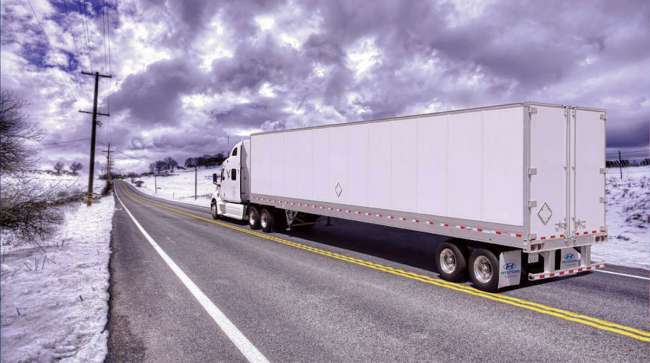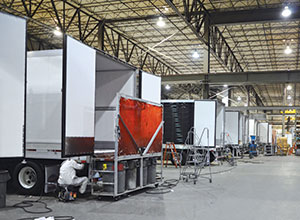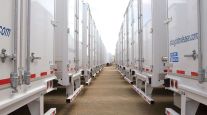Senior Reporter
October US Trailer Orders Soar to Third-Highest Level Ever

[Stay on top of transportation news: Get TTNews in your inbox.]
U.S. trailer orders for October cleared 54,000 to score the third-best gain in industry history, upending September from that position, ACT Research reported.
Another analyst pegged orders higher, but in either case, the surge signaled fleet after fleet stepped up protective moves to secure next-year slots for dry vans, especially.
Preliminary net orders reached 54,200, according to ACT. That compared with 31,786 the same month a year earlier.
Preliminary October US trailer net orders of 54.2k rank as the third strongest month in history.https://t.co/uSKvfraoac#Trailers #Transportation #truck #trucking pic.twitter.com/p1EjcbQeJO — ACT Research (@actresearch) November 13, 2020
“The big fleets are putting in big orders” into 2021, said Frank Maly, director of commercial vehicle analysis and research at ACT. “The vocational fleets are on the sidelines.”
The record for trailer orders is 58,228, set in September 2018 and that October claimed the all-time second-highest volume of 55,399.
“We are used to the cyclical nature of the trailer business and, while this has sped up faster than prior ramp-ups,” said Chris Hammond, executive vice president of sales at Great Dane, “we are well versed in managing through these times.”
Meanwhile, FTR pegged net orders at 56,221.
“I like my number,” said Don Ake, vice president of commercial vehicles at FTR. “I think my number is more accurate.”
October’s tremendous surge, he added, was a defensive move to ensure fleets wouldn’t be caught in a situation later where they needed to place an order, but there were no available slots.
“In this case it’s even more defensive than it was in 2018,” Ake said.
Then, there was so much freight to move it was hard to get trailers fast enough. Total orders that year boomed to a record 422,351.
Now, some trailer components are in limited supply — allocations are possible, and those lead to partially built trailers and fewer trailers delivered than were ordered, he said.

Trailers in the finishing area at Utility's Clearfield, Utah, plant. (Utility Trailer Manufacturing Co.)
Trailer order deliveries are now extending well into 2021 for dry vans and reefers, Craig Bennett, senior vice president of sales at Utility Trailer Manufacturing Co., told Transport Topics. “This recovery is broad-based and will continue well into next year, barring any business interruptions from other sources.”
But labor issues are in flux, trailer makers said.
Utility is filling the positions of employees who were furloughed or laid off, and did not choose to return for various reasons when offered jobs, with new employees who need to be trained.
“This slows the ability to increase production, but we are building all the trailers that we can in all areas with the exception of flatbed products, which have started to come back to life, finally,” Bennett said.
Another executive pointed to the supply chain’s workforce.
“We’ll be watching how those shifts come online through the end of this year and through the first quarter of 2021 and that’s the constraint that we’ll be basing our labor off,” said Wabash National Corp. CEO Brent Yeagy in a recent earnings call.
He added: “We’ll be looking to increase capacity roughly through the entire year. The supply chain will get their legs underneath them.”
At Great Dane, hiring is picking up as production ramps up.
“We plan to continue to hire into 2021,” said Hammond. “It’s certainly a competitive labor market and we think that will continue for the next year.”
As for additional demand, he expects “flats will come back later next year and join the party.”
At Hyundai Translead, while its workforce is positioned “very well, we continue to maintain very tight communication with the supply base and are confident in their abilities to support the demand we are facing,” said Sean Kenney, the trailer maker’s chief sales officer.
Its dry van segment has been strong and Hyundai Translead also has seen gains in intermodal and refrigerated trailers, he said.
At the same time, Ake said trailer makers’ decision years ago to expand production plants seemed prescient by the time 2019 ended with almost 330,000 trailers — and again with this current surge.
“We were able to build that number. I won’t say it was easy, but we got it,” Ake said. “The trailer OEMs knew what they were doing. Even though at the time, many people made the argument they didn’t know what they were doing” in the face of a softer market when they broke ground.
We’re excited to announce enhancements to our nationwide drop-and-hook service that address the complex challenges of matching, tracking, and routing decoupled tractors and trailers.
Learn More: https://t.co/fOZ9On39HX pic.twitter.com/Cw23v0cSPy — Convoy Team (@convoyteam) November 19, 2020
Meanwhile, digital freight broker Convoy said it intends to increase the number of trailers it leases for its drop-and-hook program, Convoy Go, which has 80 shipper customers nationwide.
“Compared with traditional drop-and-hook providers, we’re able to maintain a substantially smaller fleet based on the efficiency gains of managing our fleet using machine learning and automation,” said Tito Hubert, head of product for Convoy Go. “While this technology helps us maximize trailer usage, we’re actively looking to grow our pool to meet our ever-growing demand.”
Want more news? Listen to today's daily briefing:
Subscribe: Apple Podcasts | Spotify | Amazon Alexa | Google Assistant | More




